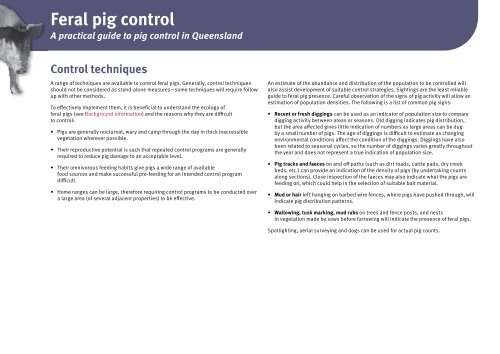Ipa Feral Pig Control Manual - Department of Primary Industries ...
Ipa Feral Pig Control Manual - Department of Primary Industries ...
Ipa Feral Pig Control Manual - Department of Primary Industries ...
Create successful ePaper yourself
Turn your PDF publications into a flip-book with our unique Google optimized e-Paper software.
<strong>Feral</strong> pig control<br />
A practical guide to pig control in Queensland<br />
<strong>Control</strong> techniques<br />
A range <strong>of</strong> techniques are available to control feral pigs. Generally, control techniques<br />
should not be considered as stand-alone measures—some techniques will require follow<br />
up with other methods.<br />
To effectively implement them, it is beneficial to understand the ecology <strong>of</strong><br />
feral pigs (see Background information) and the reasons why they are difficult<br />
to control:<br />
• <strong>Pig</strong>s are generally nocturnal, wary and camp through the day in thick inaccessible<br />
vegetation wherever possible.<br />
• Their reproductive potential is such that repeated control programs are generally<br />
required to reduce pig damage to an acceptable level.<br />
• Their omnivorous feeding habits give pigs a wide range <strong>of</strong> available<br />
food sources and make successful pre-feeding for an intended control program<br />
difficult.<br />
• Home ranges can be large, therefore requiring control programs to be conducted over<br />
a large area (<strong>of</strong> several adjacent properties) to be effective.<br />
An estimate <strong>of</strong> the abundance and distribution <strong>of</strong> the population to be controlled will<br />
also assist development <strong>of</strong> suitable control strategies. Sightings are the least reliable<br />
guide to feral pig presence. Careful observation <strong>of</strong> the signs <strong>of</strong> pig activity will allow an<br />
estimation <strong>of</strong> population densities. The following is a list <strong>of</strong> common pig signs:<br />
• Recent or fresh diggings can be used as an indicator <strong>of</strong> population size to compare<br />
digging activity between areas or seasons. Old digging indicates pig distribution,<br />
but the area affected gives little indication <strong>of</strong> numbers as large areas can be dug<br />
by a small number <strong>of</strong> pigs. The age <strong>of</strong> diggings is difficult to estimate as changing<br />
environmental conditions affect the condition <strong>of</strong> the diggings. Diggings have also<br />
been related to seasonal cycles, so the number <strong>of</strong> diggings varies greatly throughout<br />
the year and does not represent a true indication <strong>of</strong> population size.<br />
• <strong>Pig</strong> tracks and faeces on and <strong>of</strong>f paths (such as dirt roads, cattle pads, dry creek<br />
beds, etc.) can provide an indication <strong>of</strong> the density <strong>of</strong> pigs (by undertaking counts<br />
along sections). Close inspection <strong>of</strong> the faeces may also indicate what the pigs are<br />
feeding on, which could help in the selection <strong>of</strong> suitable bait material.<br />
• Mud or hair left hanging on barbed wire fences, where pigs have pushed through, will<br />
indicate pig distribution patterns.<br />
• Wallowing, tusk marking, mud rubs on trees and fence posts, and nests<br />
in vegetation made by sows before farrowing will indicate the presence <strong>of</strong> feral pigs.<br />
Spotlighting, aerial surveying and dogs can be used for actual pig counts.
















